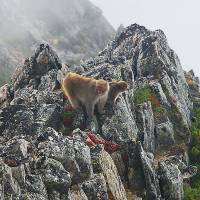Despite a growing perception that climate change is altering the habitat range of Japanese macaques in the nation's alpine areas, sightings at high altitudes are not a symptom of global warming, according to scientists.
While environmental changes have affected the movements of some species, macaques have been observed high up in mountainous areas for at least 40 years, they say.
On a recent trek near the top of 2,922-meter Mount Otensho in Nagano Prefecture, three Japanese macaques were spotted where creeping pine bushes grow along the ridges and in narrow high-altitude valleys.
Their appearance in alpine habitats has surprised many trekkers, even those with decades of experience in mountaineering.
"It's surprising to see them up here," one climber said. "I didn't know that monkeys climb so high these days."
Many climbers believe the presence of macaques in the high mountains has similar origins to the growing populations of Sika deer.
The numbers of deer are expanding in mountainous areas because less snow is falling in the winter, a phenomenon blamed on global warming. Because of this, the deer are posing a serious threat to endemic plant species that grow in the high mountains.
But Shigeyuki Izumiyama, a professor at Shinshu University, which is located in Nagano Prefecture, who has studied macaques in the Japan Alps for years, says the phenomenon is not a recent one, explaining that reports of simians on mountains higher than 3,000 meters have been known for at least the past 40 years.
The highest point where macaques have been sighted is on the summit of 3,180-meter-high Mount Yarigatake in the Northern Alps, Izumiyama said.



